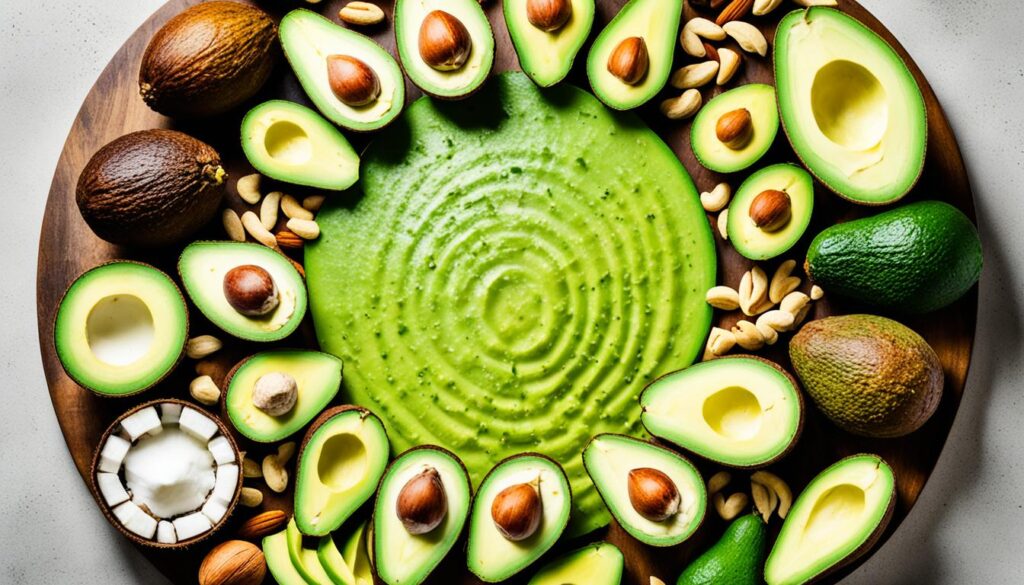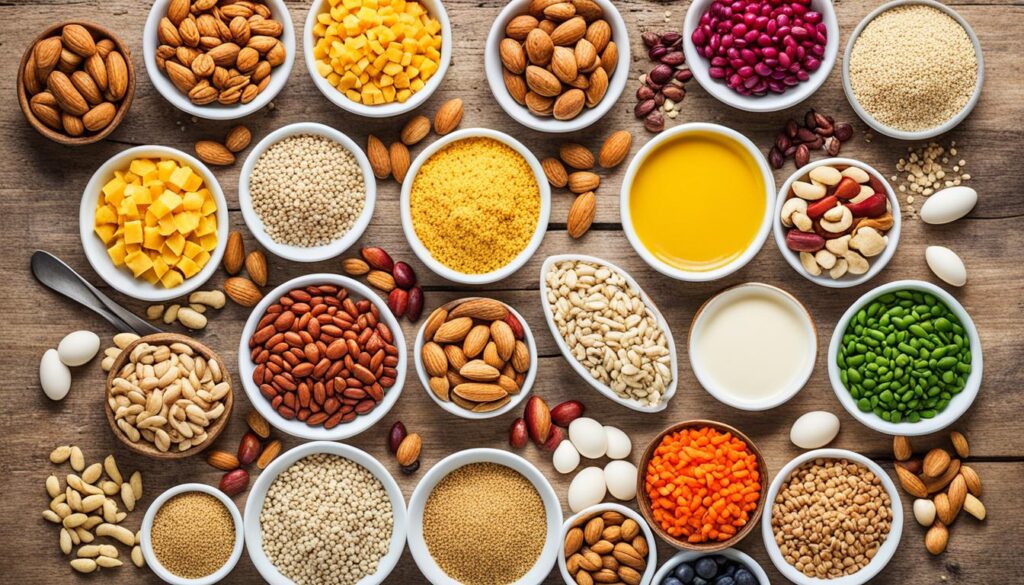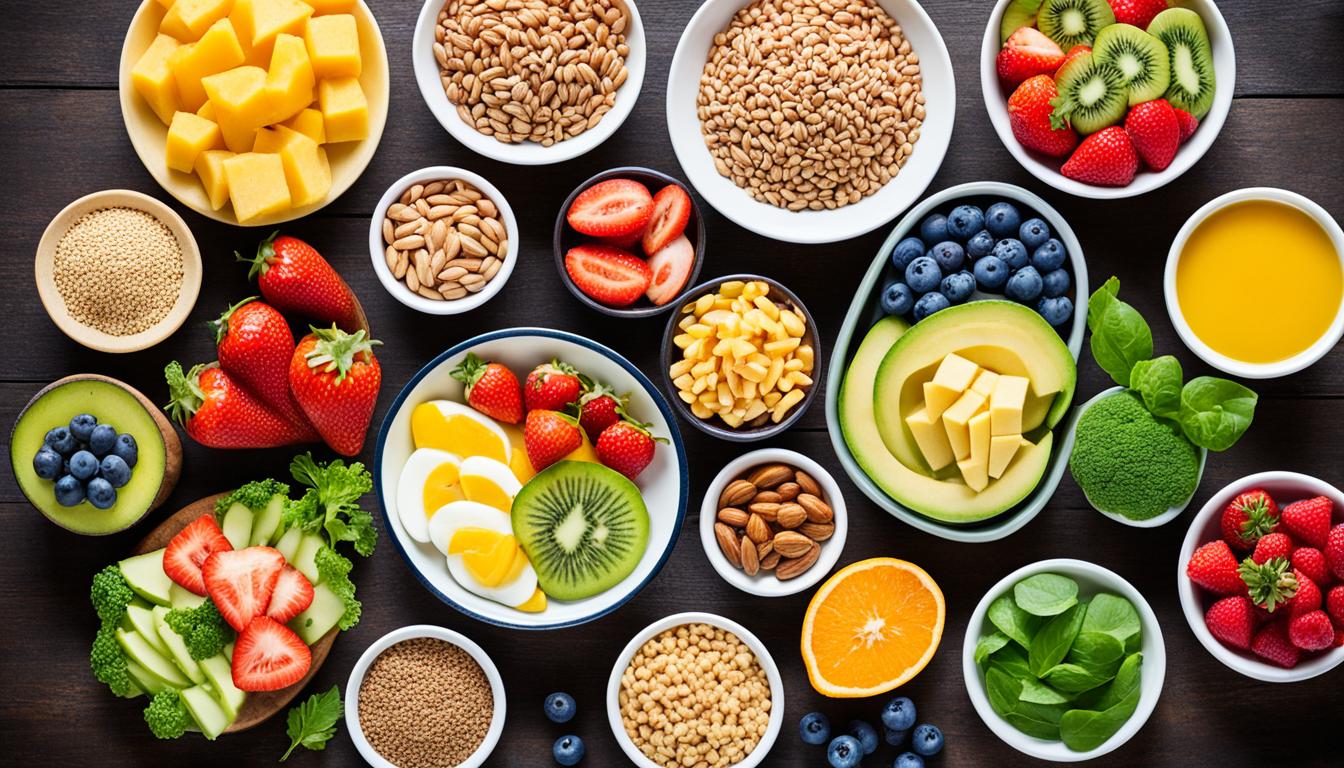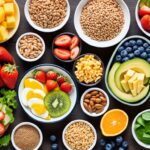Are you finding it hard to stay at a healthy weight and feel good? The secret might be having a balanced diet just for you. But, what is a balanced diet and why is it good for you? Start a journey to learn about the power of eating right for your best health.
A balanced diet helps your body work well by giving it the nutrients it needs.1 It means most of your daily calories should be from fruits, vegetables, whole grains, legumes, nuts, and lean proteins. The Dietary Guidelines for Americans show how much of these nutrients you should have each day. Your sex, age, and how active you are decide how many calories you need.1 Foods with mainly calories and little nutrition are “empty calories.” It’s best to eat these only in small amounts.
Your body works better with a balanced diet because it gets all the right nutrients. If your nutrition is off, you might get sick more often, feel tired, and not do as well.1
Key Takeaways
- A balanced diet gives your body all the key nutrients to work its best.
- The calories you need depend on your sex, age, and how active you are.1
- Cutting down on “empty calories” and picking nutrient-rich foods is big for staying healthy.1
- Adding fruits, vegetables, whole grains, lean proteins, and healthy fats to your meals can protect you from serious health issues.1
- Using the plate method can help you eat in a balanced and nutritious way.1
What is a Balanced Diet?
A healthy, balanced diet includes different kinds of foods like fruits, vegetables, grains, dairy, and proteins.2 Foods from these groups are rich in various nutrients. For example, protein foods are found in meat, eggs, fish, beans, nuts, and legumes. Whole grains have the entire grain, giving us more vitamins, minerals, and fiber. Dairy has protein, calcium, and vitamin D. Plus, healthy fats help our bodies work well.
Essential Nutrient Groups
3 Proteins should make up a quarter of your daily food, about 5.5 ounces. Focus on lean meats like beef, fish, and chicken, along with eggs, nuts, and beans.3 Aim for fruits to fill another quarter of your plate, roughly 2 cups a day. Choose from fresh, dried, or frozen options in lots of colors to get different nutrients.3 Vegetables are also a quarter, about 2.5 to 3.5 cups daily. Mix it up with dark greens, reds, oranges, legumes, and starchy veggies. This way, you get a range of vitamins and minerals.3 The final quarter is for grains, about 6 ounces each day. Go for whole grains like oats, quinoa, or whole wheat for more fiber and nutrients.
Portion Sizes and Calorie Needs
1 The average adult needs around 2,000 calories a day to keep their weight steady. But, this amount changes based on age, gender, and how active you are.3 Men often need more calories than women. Kids need less than teenagers, who usually need the most until they’re 30. After that, you might need fewer calories each year.1 Depending on your age, gender, and how much you exercise, you might need anywhere from 1,000 to 3,200 calories a day.
Importance of a Balanced Diet
Having a balanced diet keeps your body strong and wards off sickness.4 It helps fights diseases like heart issues, diabetes, and cancer.4 If you eat lots of veggies and fruits, you’re less likely to get obese or face these health problems.4
Disease Prevention
The food we eat is crucial. 4 out of 10 top causes of death in the U.S. are diet-related. These include heart disease, cancer, strokes, and type 2 diabetes.1
Growth and Development
Kids need to eat healthily for their bodies and minds to grow right. Without good food, they might have trouble getting bigger, learning at school, and staying healthy.4 Also, what they eat as kids can shape their food choices as grown-ups.4
Exercise is another key part. It helps kids avoid getting too heavy and keeps them from diseases like diabetes and high blood pressure.
4 Breastfeeding helps babies grow healthy and not too big.4 Adding safe and good foods when they’re 6 months old is very important. That’s why it’s key to start them on a variety of solid foods at the right time.
| Nutrient Guideline | Recommended Intake |
|---|---|
| Total fat consumption | Should not exceed 30% of overall energy intake to avoid unhealthy weight gain.4 |
| Sugars | Should represent less than 10% of total energy intake for a healthy diet.4 |
| Salt intake | Keeping under 5g per day helps prevent hypertension and reduces the risk of heart disease and stroke.4 |
Understanding Food Groups
Fruits offer more than just being good for you. They are a sweet and healthy option for snacking or dessert. Even though they have sugar, it’s natural. Unlike sugary treats, fruits also give you fiber and important nutrients.5 Vegetables are rich in vitamins, minerals, and antioxidants. Eating a mix of colors ensures you get a variety of nutrients. Greens, like spinach, are especially nutrient-rich.
Whole Grains
Many breads and pastries use refined white flour, which lacks key nutrients. Whole grains, on the other hand, are rich in fiber, vitamins, and minerals.5 They not only boost the nutrition of your meals but also add interesting flavors and textures. Switching to whole grain bread, pasta, and rice is a healthier choice.
Lean Proteins
Proteins from meats and beans are vital for your body. They help heal wounds and maintain or grow muscles. Opt for lean options like chicken, fish, or beans.5 Be careful with processed meats as they can be harmful. For those who don’t eat meat, nuts, beans, and soy are great protein sources.
Dairy and Alternatives
Dairy offers important nutrients such as protein, calcium, and vitamin D.5 Nowadays, there are many non-dairy substitutes for those who can’t or choose not to eat dairy. These include milk made from flaxseed, almonds, soy, and various other plants. They are often enriched with additional nutrients, serving as good alternatives to cow’s milk.
Healthy Fats vs Unhealthy Fats

Our body needs fats for energy and to stay healthy. But eating too much fat can make us gain weight. This is because it adds extra calories that we don’t need.6 In the past, doctors said we should avoid some fats because they might make our cholesterol go up. But recent studies show that not all fats are bad for our heart.7 Now we know that some fats can even help our heart health a lot, by keeping our arteries clear. About 10% or less of the calories we eat can come from fats like butter and cheese.8 But we should always avoid trans fats.
Olive oil is a great example of a healthy fat. Extra virgin olive oil, in particular, is very good for us. It is the purest form of olive oil and not too processed.
8 Eating fats like monounsaturated and polyunsaturated fats instead of saturated fats is good for our heart. It can help lower our bad cholesterol.8 Saturated fats, though not all bad, can raise our bad cholesterol. This can lead to heart problems.8 Trans fats are the worst for our hearts because they make our cholesterol even worse.
8 To cut down on bad fats, we should cook with oils that are liquid at room temperature. Making salad dressings with these oils can be a tasty choice.8 We should also use ground flaxseed and nuts in our food. Eating avocado and choosing fish and plant-based proteins can really help.
7 Not all fats are the same. Some fats, like mono and polyunsaturated fats, are good for our hearts.7 But when it comes to our health, not all saturated fats are equal. Things like how long the fats are can affect our health differently.7 The source of the fat matters too. For example, avocados are better for our cholesterol than bacon.
7 Processed meats, like hot dogs and bacon, may increase our heart disease risk and early death.7 Eating too much red meat is also risky. Research that looked at many adults shows a link between red meat and a higher chance of dying from heart disease.
Balanced Diet for Weight Management
Exercise reduces the risk of obesity and diseases like type 2 diabetes. It’s vital to limit empty calories and eat nutrient-rich foods for good health. A balanced diet helps maintain a healthy weight.
A dietitian looks at your age, sex, and more to figure out how many calories you need. They recommend eating certain amounts of dairy, fruits, proteins, and other foods. Half your plate should be fruits and vegetables at every meal.
Include lean proteins like turkey and fish in your meals. Eat fat-free or low-fat dairy and limit sugars. Choose whole grains over refined grains for more protein and fiber.
Choose healthy oils like canola and olive over saturated and trans fats. Fruits and veggies are low in calories but rich in fiber and vitamins. Eat whole fruits and veggies, not juices, for their fiber content.
| Nutrient Group | Recommended Servings |
|---|---|
| Fruits and Vegetables | Half of your plate should consist of fruits and vegetables9 |
| Lean Proteins | Included in diet, such as white meat, fish, nuts, and beans9 |
| Whole Grains | Preferred over refined grains for higher protein and fiber9 |
| Healthy Fats | Recommended over saturated and trans fats9 |
| Dairy | Fat-free or low-fat, limit added sugars9 |
Snack wisely, stay hydrated, and avoid sugary drinks for a healthy diet.
Making Nutritious Choices When Eating Out
Eating out doesn’t mean you have to give up on healthy eating. Try looking for fast-food joints or fusion kitchens that serve nutritious options.10 It’s key to pay attention to the cooking methods used. Grilling, broiling, frying, and deep-frying can add unhealthy substances to your meal. Choose items that are baked, broiled, poached, or pressure-cooked for a better choice.10
11 Studies have shown that eating out can lead to eating too much and picking less healthy foods (1, 2, 3, 4). Yet, you can make smart, nutritious decisions.11 Being mindful about what you eat has been linked to picking healthier options in restaurants. It can also help you avoid overeating.11
11 Drinking water before eating can help you eat less. One study found that those who drank water before meals ate fewer calories and lost more weight.11 Sharing food or ordering smaller portions is a good way to cut down on calories when dining out. This is often recommended for those trying to lose weight.11 Picking drinks with fewer calories, like low-calorie mixers with alcohol, can also lower your meal’s overall calorie count.11
10 Food from restaurants can have a lot of extra calories, fat, and salt from cooking oil, butter, and salt. It’s best to choose meals made without these or sugar to help control how many calories you eat.10 Drinks like smoothies, alcohol, and soda can also add a lot of calories. Opting for water or flavored water with something like lemon or cucumber is a healthier choice.10
10 Starting your meal with fried or creamy appetizers can add a lot of calories. The serving sizes in restaurants are often bigger than they need to be. Sharing dishes or saving some for later can help.10 Swapping out carb-heavy sides for steamed vegetables can cut down on calories and fat. Be careful with toppings like mayonnaise, bacon, and avocado, as they can add a lot to your meal’s calorie count.10
10 Even salads can be high in calories, with ingredients like fried tortilla strips, cheese, dressing, and bacon bits. It’s smart to ask for dressing on the side and use it sparingly. Adding more fresh veggies to your salad can increase its nutrients without adding too many calories.10 Cutting back on salt and using healthier flavorings like lemon juice or vinegar can also make a big difference.10
Balanced Plate Method
The USDA’s program, “ChooseMyPlate,” suggests that half your plate should be fruits and veggies. They are packed with vitamins, minerals, and antioxidants.12 Plus, choosing local, seasonal produce can save you money.
Whole Grains
For the other half, “ChooseMyPlate” says to pick whole grains like whole wheat bread and brown rice. These are better than refined grains.12
Lean Proteins
Next, fill a quarter of your plate up with proteins. This means things like lean meats, fish, beans, and eggs. They help your body stay strong.121314
Incorporating More Protein

Protein is key for healing wounds and building and keeping muscles.15 It can control feelings of hunger and fullness more than other nutrients.15 For those looking to lower their food cravings, choosing a meal high in protein is better than one packed with carbs. This is especially true for people with obesity.15
Benefits of Protein
The 2020–2025 Dietary Guidelines suggest females eat 46 grams (g) of protein a day, and males, 56 g.15 Going above these amounts may reduce the risk of various health issues, from type 2 diabetes to heart problems.15 It can also help with losing weight, building more muscle, and just generally feeling healthier.15
Protein Sources
Protein can come from dairy, nuts, eggs, beans, peanut butter, and lean meats.15 Adding protein to every meal and snack can help you eat less, avoid overeating, and manage weight.15
Take cheddar cheese, for example. An ounce has 7 g of protein and fewer calories than chips.15 Have three eggs in the morning, and you get 19 g of protein. It keeps you full, cutting down your calories later.15 Almonds, with 6 g of protein per ounce, are also low in carbs. This makes them a smart snack choice.15 Greek yogurt is another good pick. A serving has 10 g of protein and helps you feel full longer.15 A 1-ounce serving of lean jerky offers about 9 g of protein. It’s an easy way to boost your intake.15 Think about cottage cheese too; it matches eggs in protein content and will keep you satisfied.15 Edamame, great for vegetarians and vegans, has 18.4 g of protein in a cup. It’s a rich source of this nutrient.15 Turning to canned fish, such as salmon, you get 19 g of protein. Plus, it’s full of omega-3s for heart health.15 Finally, whole grains like quinoa are good sources, offering 8-9 g of protein per cup.15 Beans and legumes are also not to be missed. White beans have 24.5 g and lentils 23 g per 100 g. They’re powerhouse options.15
Strategies for Balanced Eating
Planning your meals and snacks ahead can help make better food choices. Make a list before shopping. Stick to it to avoid buying unhealthy foods on a whim. Cooking at home gives you more control over what you eat.
Cooking at Home
Cooking at home helps reduce obesity risk and betters diet quality, especially for kids.16 Knowing what’s in your meals means no worrying about hidden stuff. You can make enough for leftovers, too.
Healthier Cooking Methods
The way you cook can affect your food’s health benefits. Methods like grilling and deep-frying can create harmful compounds. But baking, broiling, and more don’t.16
Balanced Diet and Exercise
Eating healthily and moving a lot are key to staying fit and well.17 Adults should aim to exercise moderately for 2 hours and 30 minutes a week. Also, they should do muscle-building activities on 2 days. This helps keep the mind sharp, uplifts mood, controls weight, and cuts disease chances.17
Being too heavy leads to health troubles like some cancers and heart issues.2 Eating right and being active regularly keeps your weight in check. It’s best to combine cardio, strength, and flexibility exercises. Doing so brings the most health and fitness gains.18
It’s important to eat a mix of fats, proteins, and carbs, in the right amounts.17 Also, working out often is crucial to handle weight and dodge sickness. Making these smart choices lets your body work better, getting all the benefits of diet and exercise.17
Conclusion
Eating a mix of healthy foods from each food group is key to being healthy.19 It gives you important vitamins, proteins, and other nutrients. These help your body work right, stop diseases, and make you feel good.20
To eat well, pick your meals smartly and cook in healthy ways. By doing this, you’ll learn how to eat a balanced diet. This diet will keep your body healthy and strong.20
The guidelines suggest you eat at least 2 servings of fruit and 5.5 of veggies every day.19 Fruits like apples, grapes, and bananas are good for you. Veggies include carrots, kale, and corn. Eating these can help you stay at a good weight and fight off many common diseases.20
Making good food choices, planning, and cooking in healthy ways is essential. A balanced diet isn’t just about what you eat. It’s also about how you make and eat your food. This approach is the key to staying well and full of life.20
FAQ
What is a balanced diet?
A balanced diet gives your body all the necessary nutrients. This includes a mix of fresh fruits, vegetables, whole grains, and lean proteins.
Why is a balanced diet important?
It keeps your body healthy, lessening the risks of disease and tiredness. A balanced meal plan helps your body work well.
What are the essential nutrient groups in a balanced diet?
They are fruits, vegetables, grains, dairy, and proteins from meat, eggs, and beans.
How many calories do I need per day?
You’ll probably need 2,000 calories daily. But this can change based on your age, gender, and how active you are.
What are the benefits of eating a variety of fruits and vegetables?
Fruits and veggies are packed with vitamins and minerals. Ensuring you eat different types helps you get more nutrients.
Why are whole grains better than refined grains?
Whole grains have more nutrients and fiber. They’re a better choice than refined options like white bread and pasta.
What are healthy sources of protein?
Good sources of protein are lean meats, fish, and eggs, along with plant-based options like beans and nuts. Protein is key for healing and keeping muscles strong.
What are the differences between healthy and unhealthy fats?
Healthy fats like olive oil are good for you. But avoid trans fats. Eating too much saturated fat is also not recommended, though some is okay.
How can a balanced diet help with weight management?
A well-rounded meal plan can keep your weight in check. Foods high in protein and fiber help you feel full longer.
What are some tips for making healthier choices when eating out?
Pick places with healthy items on their menu. Also, choose foods that are grilled or baked over fried options.
How can I incorporate the “Balanced Plate” method into my meals?
The “ChooseMyPlate” method suggests half your plate should be fruits and veggies. Add in whole grains and a protein source for the other halves.
Why is it important to include enough protein in my diet?
Protein helps your body heal and keeps muscles strong. It also helps control your appetite, making you less likely to snack.
What are some strategies for maintaining a balanced diet?
Plan your meals, cook at home, and use healthy cooking methods. These steps can assist in sticking to a nutritious food plan.
Source Links
- https://www.healthline.com/health/balanced-diet
- https://www.nhs.uk/live-well/eat-well/how-to-eat-a-balanced-diet/eating-a-balanced-diet/
- https://www.webmd.com/diet/what-is-a-balanced-diet
- https://www.who.int/initiatives/behealthy/healthy-diet
- https://www.nia.nih.gov/health/healthy-eating-nutrition-and-diet/healthy-eating-you-age-know-your-food-groups
- https://www.healthpartners.com/blog/unhealthy-vs-healthy-fats/
- https://www.healthline.com/nutrition/healthy-vs-unhealthy-fats
- https://www.roswellpark.org/cancertalk/202104/fats-101-difference-between-healthy-unhealthy-fats
- https://medlineplus.gov/ency/patientinstructions/000330.htm
- https://www.piedmont.org/living-real-change/8-tips-for-making-healthy-choices-at-a-restaurant
- https://www.healthline.com/nutrition/20-healthy-tips-for-eating-out
- https://nutritionsource.hsph.harvard.edu/healthy-eating-plate/
- https://diabetes.org/food-nutrition/eating-healthy
- https://www.ucsfhealth.org/education/ild-nutrition-manual-plate-method-for-healthy-meal-planning
- https://www.healthline.com/nutrition/14-ways-to-increase-protein-intake
- https://www.healthline.com/nutrition/healthy-eating-tips
- https://healthyliving.extension.wisc.edu/articles/balancing-food-and-physical-activity/
- https://www.healthline.com/health/fitness-exercise-eating-healthy
- https://www.linkedin.com/pulse/what-balanced-diet-conclusion-gabrielle-stanislaus
- https://dpuhospital.com/blog/importance-of-balanced-diet-for-healthy-life/

